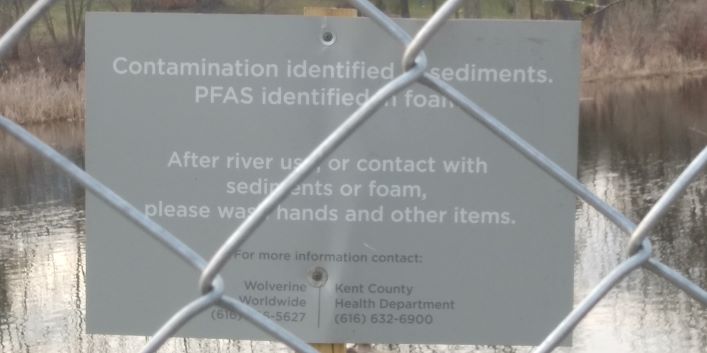PFAS contaminates surface waters and concentrates in foam
PFAS chemicals concetrate in foam on contaminated surface waters leading to warnings to keep people from exposure to these hazardous chemicals

Sign along the White Pine Trail in Rockford warning about PFAS in the foam
Rockford, Michigan is in Kent County just north of Grand Rapids. The community continues to be the home of Wolverine World Wide, the parent company for well-known brands like Merrill, Hush Puppies, Keds, Saucony and Sperry.
On the north end of Rockford’s downtown, on the banks of the Rogue River, sits a 15-acre grassy field that was once the site of a tannery used by the shoe company. At this site, Wolverine used water-proofing chemical blends that included PFAS in the shoes they manufactured. These water-proofing chemicals seeped into the soils and groundwater at the site, and now are moving into the Rogue RIver.
A walk past the site on the popular White Pine Trail reveals some large earth moving equipment, and a floating barrier in the Rogue as Wolverine continues clean up at the site. The floating barrier helps prevent PFAS-contaminated groundwater from seeping into the Rogue. Downstream from the old tannery site, the Rogue is popular with fly anglers who use the White Pine Trail for easy access to the riffles and rocks that provide habitat for fish. Yet with the barrier in place, the existing fish contamination requires “do not eat” advisories.
In March, 23rd’s blog post I highlighted a sign on the Huron River in Ann Arbor warning people not to touch foam on the river because of PFAS contamination in the water. That’s not the only popular public place with warnings about PFAS-laden foam. I took the picture above just north of downtown Rockford on the White Pine Trail.
PFAS tends to concentrate in foam because of its chemical properties. PFAS acts as a surfactant. Without wading into the chemistry of why, the important point is PFAS is great for making bubbles. That’s why it’s been used in fire fighting foams and foams used to protect workers in electroplating facilities. Once PFAS gets into the surface water it starts to form bubbles, and that’s why we see these warning signs in places like Ann Arbor, Rockford, and up north in Oscoda. The foam on the surface waters can have much higher concentrations of PFAS than the water itself.
Our communities shouldn’t be burdened with these toxic legacies. We need to hold polluters accountable and get these sites cleaned up, because eventually, groundwater pollution ends up in our surface waters.
Nathan
